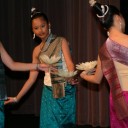Lao Heritage Foundation
July 12th, 2008 | Published in Culture
“Bring an umbrella!†were the first words off most everyone’s lips when I mentioned Seattle was my vacation destination. While it never rains in southern California, I opted to take my chance with notoriously overcast northwestern Washington instead. As luck would have it, Puget Sound welcomed me with plenty of sunshine and an even brighter evening. To my pleasant surprise my visit happened to coincide with an enthusiastic and jovial cultural show titled “Forte†organized by the Lao Heritage Foundation and the Kinnaly Dance Troup to showcase talented young stars in music, dance and composition.
Now don’t get me wrong. I have seen my fare share of Laotian ethnic programs and costume exhibitions, with earnest parents obligating their children to play dress-up and do things they would be too embarassed to talk about the next day in school. Take my word. I’ve been there. Admit it. We all have. But, Forte had something different. As soon as I arrived I was warmly greated by friendly young people. None of the ushers or organizers could have been more than 35. Even the venue was impressive. A modern community theater, complete with proper stage lighting and comfortable seating. Different indeed.
The Lao Heritage Foundation (LHF) is a non profit national organization based out of Washington D.C., established in 2004 by a group of young Lao American professionals and artists across the US who wanted to learn more about their culture and to share that knowledge with other Lao Americans and the world. The mission of the Lao Heritage Foundation is to preserve and promote Lao culture through the arts, and transmit it to future generations.
LHF representative Pom Outama Khampradith, explains that because Laos is deeply rooted in the traditions of oral transmission, very little has been recorded, and as a result there are even fewer resources on Lao arts and culture in the English language that the younger Lao American generation can access. LHF has begun the tedious work of recording, in the form of audio and video, traditional music masters, including Bounseung Sinanonh from Fresno, California, one of the world’s best “kaen†players, and Thongtanh Souvannaphanh, one of the last traditional “saw†masters from Washington D.C. They are also documenting their music in the form of tablature and western notation. In addition, LHF provides and support the apprenticeship of traditional music that spans three generations: from the masters training the teacher who in turn transcribes the sounds onto music notes, in order to teach it to Lao American youth. The project is currently underway in the cities of Seattle, Washington, and Providence, Rhode Island.
In fine arts, LHF partners with Tiao Nithakhong Somsanith, who documents and showcases the many treasures of Laos through his uniquely exquisite paintings and the royal art of gold thread embroidery. In literature, they provide support for the work of a very talented artist/animator from Chicago, Illinois, Nor Sanavongsay, whose project is to give life to a witty fable character Xieng Mieng. In performing arts, they are proud to sponsor Kinnaly – Lao Traditional Music and Dance Troupe from Seattle, Washington, whose members meet once a week all year round to learn, preserve, promote, and share the arts of Lao traditional music and dance.
Students of Kinnaly were invited to showcase their “Forte†and share the stage to express who they are as Lao Americans. Acknowledging that Lao traditional music and dance is not for everyone, the group strongly believes that arts in general is life enriching and well worth encouraging in the youth. The American born generation of students each came up with their own unique concept of bridging the cultural gap, resulting in a fresh blend of the old and the new. Performances ranged from traditional music and dance, to classical piano recital, rap, singing, comedy, and hip hop.
The keenly supportive audience also reflected the wide diversity of the local Laotian communty. Restless younger siblings, proper older aunties, cousins in baggy jeans, sisters in two piece suits. Not everyone got the Brady Bunch jokes, some swayed with the guitar solos, others nodded with the urban beats. But, everyone had muted giggles when a 5 year old performer fell out of step and the young saw player forgot his place. Piano solos and the Khaen choir were received with impressive cheers. When the traditional dancers did a double take, exchanging their silk dresses for jeans and short skirts to angst out Alexz Johnson’s “Who Am I Fooling†and the Laotian Pop song “Don’t Care If You Don’t Love Meâ€, the excited response was inspiring. If I where a decade younger, I would have felt encouraged climb on stage myself. With the overwhelmingly positive feedback, LHF plans to host “Forte†every year in the spring.
According to the 2000 census, there are over 9,000 Lao in the state of Washington with over 6,000 living in the Seattle area, and a little over 6,000 Lao in the state of Oregon. The Seattle Lao community is very vibrant and active, with three Lao temples, about a dozen associations and organizations, several Lao restaurants, grocery stores and other successful Lao businesses. Most of the cultural activities revolve around Buddhist celebrations at the temples, fundraising events, concerts by Lao artists, private “soukhouaneâ€, and weddings.
If you are interested in Lao Heritage Foundation programs and would like to start and/or collaborate with LHF to implement them in your community, please don’t hesitate to contact them. “We also welcome comments and guided recommendations,†says Pom Outama, “It is with everyone’s help and support that we can preserve, promote, and transmit our culture through the arts. We believe that it is through alliance and partnership that we can move our community forward.†For more information and details about their programs and upcoming projects, please visit their website at www.laoheritagefoundation.org.
A version of this article appears in Lao Roots Magazine issue #5 (2008).







